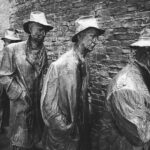 Unsplash/Sonder Quest
Unsplash/Sonder QuestHistory doesn’t always repeat itself, but it often rhymes. Across different eras, regions, and cultures, humanity has found itself facing remarkably similar events—wars sparked by political succession, financial crashes triggered by overconfidence, or failed invasions that should have been impossible to lose. Sometimes the parallels are so uncanny, they feel like reruns. Here are some of the most striking examples of nearly identical historical events that happened centuries apart.
The Great Fire of London (1666) and the Grenfell Tower fire (2017)
Both tragedies revealed major issues with building materials and safety regulations. The Great Fire of London started in a bakery and swept through the city’s timber buildings, leading to widespread destruction and forcing major changes in building codes.
Centuries later, the Grenfell Tower fire exposed flaws in modern cladding materials and fire safety protocols. In both cases, a single fire turned into a national scandal, prompting public outcry and legislative change, albeit too late for many victims. The BBC’s timeline of Grenfell gives more detail on the events and their aftermath.
The South Sea Bubble (1720) and the Dot-Com Crash (2000)
In the early 18th century, the South Sea Company promised massive profits through trading rights in South America. Its share price skyrocketed before collapsing dramatically, ruining countless investors. The frenzy was fuelled by speculation and overconfidence, not solid fundamentals.
In eerily similar fashion, the dot-com boom of the late 1990s saw investors pour money into tech start-ups with vague business plans. When the bubble burst, trillions in market value disappeared almost overnight. The lessons still being learned are plenty, that’s for sure.
The Fall of Rome (5th century) and the collapse of the Soviet Union (1991)
The Roman Empire didn’t fall in a single day. It was weakened by internal corruption, economic struggles, overextension, and external pressures, culminating in the sacking of Rome in 476 CE.
The Soviet Union collapsed for many of the same reasons: a bloated bureaucracy, economic stagnation, declining morale, and pressure from both internal dissent and foreign rivals. In both cases, a powerful superstate crumbled under its own weight.
The Spanish flu pandemic (1918) and the COVID-19 pandemic (2020)
A century apart, these global health crises shared uncanny similarities. Both originated unexpectedly, spread rapidly, and overwhelmed healthcare systems. Public spaces were closed, masks became common, and misinformation spread almost as fast as the virus.
Despite the time gap, many of the public health strategies were identical, and many of the public responses, from panic buying to conspiracy theories, were too. The CDC has detailed information on the 1918 pandemic.
The 1848 European revolutions and the Arab Spring (2011)
In 1848, a wave of uprisings swept across Europe, sparked by demands for democratic reform, press freedom, and economic fairness. Though most were ultimately crushed, they reshaped political consciousness across the continent.
The Arab Spring, beginning in Tunisia in 2010, similarly spread across the Middle East and North Africa. Ordinary citizens demanded political change and an end to authoritarian rule. Both movements were fuelled by economic despair, frustration with corrupt elites, and new forms of communication—the printing press then, social media more recently. Al Jazeera’s Arab Spring timeline highlights key moments of this period.
The invasion of Russia by Napoleon (1812) and by Hitler (1941)
Two of history’s most infamous military campaigns ended in disaster for the invading army—thanks largely to Russian winter and overconfidence. Napoleon’s 600,000-strong army was decimated by cold, starvation, and guerrilla resistance. More than a century later, Hitler made the same mistake.
Operation Barbarossa saw German forces push deep into Soviet territory, but logistics collapsed and the harsh winter halted progress. In both cases, the invaders underestimated Russia’s scale, climate, and capacity for resilience.
The Wall Street Crash (1929) and the Global Financial Crisis (2008)
Two of the most devastating economic collapses in modern history began with unchecked financial speculation. In 1929, the stock market crash sparked the Great Depression, with bank failures, mass unemployment, and a collapse in global trade.
In 2008, a housing market bubble—fuelled by risky subprime lending and financial deregulation—burst and sent shockwaves through the global economy. Central banks stepped in with emergency measures. The Bank of England breaks down what happened in 2008.
The assassination of Julius Caesar (44 BCE) and the assassination of John F. Kennedy (1963)
Both leaders were at the peak of their influence when they were killed, and both deaths shook their nations to the core. Julius Caesar was stabbed by senators who feared he was becoming a dictator. His assassination led to civil war and the fall of the Roman Republic.
John F. Kennedy was assassinated in Dallas under mysterious circumstances, prompting endless theories and national mourning. While the motives and settings differed, the shock and political consequences were deeply parallel, signalling the end of an era and prompting major changes in governance.
The Great Depression (1930s) and post-pandemic inflation (2020s)
While the causes aren’t identical, the economic aftermath of major crises shows recurring patterns. The Great Depression was marked by deflation, unemployment, and massive government intervention.
Post-COVID, many countries saw the opposite: inflation, disrupted supply chains, and rising interest rates. Governments again played a major role in economic recovery. The IMF continues to monitor and respond to pandemic-related economic fallout.
The fall of Constantinople (1453) and the fall of Saigon (1975)
Both cities represented the symbolic end of a major political era. Constantinople’s fall to the Ottoman Empire marked the definitive end of the Byzantine Empire and changed the balance of power in Europe and the Middle East. It was a shock to Christian Europe and sparked a wave of intellectual migration westward.
The fall of Saigon, similarly, ended the Vietnam War and marked a turning point in American foreign policy and Cold War politics. Both collapses involved evacuations, last-ditch defences, and long-term political ramifications.
The rise of printing (15th century) and the rise of the internet (20th century)
When Johannes Gutenberg introduced the movable-type printing press, it revolutionised the spread of information. Literacy increased, religious reform movements exploded, and traditional power structures were challenged.
Fast-forward to the late 20th century, and the internet had a similarly disruptive effect. It broke down barriers to information, changed commerce, and redefined communication. Both revolutions made knowledge more accessible—and both had unintended consequences that continue to unfold.



